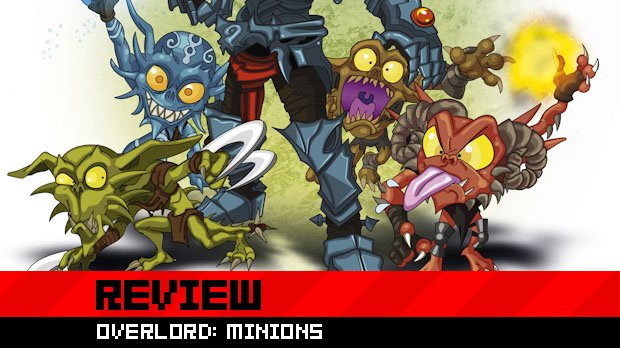Codemasters definitely pushed the boat out with its Overlord franchise this summer. Following the surprising success of the original game, this year saw three games in the series release simultaneously: Overlord II on the Xbox 360, PS3 and PC, Overlord: Dark Legend on the Wii and Overlord: Minions on the DS. The latter game was the least talked about and was certainly the most curious, so I was naturally very eager to play it.
Play it is what I have most assuredly done, and we now present to you our full verdict. Does taking direct control of the Overlord’s grinning slaves feel as fun as it sounds, or does Minions fall into the same traps as its bigger brothers, having some great ideas that are bogged down by poorly implemented controls and design decisions?
These questions we shall answer, as we review Overlord: Minions.

Overlord: Minions (DS)
Developer: Climax Studios
Publisher: Codemasters
Released: June 23, 2009
MSRP: $29.99
Overlord: Minions is cuter and more cartoony than most Overlord games, as players take the role of a rather adorable dark master. Aided as always by Gnarl, players have to take down an emerging new threat known as The Kindred, who are meddling with ancient relics that are connected in some way to long-extinct Dragons that used to roam the world. Unlike other games, where players command Minions to do their bidding, this DS spin-off is all about taking direct control of the cackling little gremlins.
Players will command a “special farces unit” comprised of one of each Minion type. Giblet is the brown fighter, with a high HP value, strong attacks, and power to push heavy blocks. Stench is the green assassin who can make himself invisible, survive poisonous areas and (sigh) fart out flammable clouds. Blaze, the red minion, specializes in throwing fireballs and can pass through flame, while the blue Zap walks in water, heals fellow minions, and can directly attack spectral enemies.
Overlord: Minions predominantly takes the form of a puzzle game where players use the unique attributes of their team to get past obstacles and progress through the level. Sometimes stages require the use of only two or three minions, while others will require all four creatures. Though the puzzles never get particularly challenging, they’re rather clever and it can be quite satisfying to clear a stage.

The game is controlled entirely by the stylus, and it sadly suffers as previous touchscreen-only games like Phantom Hourglass have. Trying to make the stylus do absolutely everything simply doesn’t work as well as developers hope it will. The control method, while perfect for a limited number of tasks, is too unwieldy for multiple responsibilities and the game frequently gets confused. Trying to get Zap to heal other minions is a nightmare, since moving the stylus will either make him do what you want or just walk around aimlessly. Getting Minions into the correct place and making them do the right thing in any situation sometimes feels like a game of luck.
It’s made worse by the fact that the minions themselves are thoroughly stupid. They’ll wander into trouble if you let them, and if you’re sweeping the entire team, stragglers have no problem walking into fire or poison, even if it hurts them, and they’ll regularly get stuck on a corner or otherwise trail so far behind that they stop following the unit and wait for you to manually make them catch up.
As seems par for the course with Overlord games, the problems are quite tragic because they hold back what is otherwise a great game. Minions is full of cool ideas, especially the boss battles. While the first few boss fights are frustrating affairs, some of the later ones really put the emphasis on making the minions fight as a team. It’s also quite impressive how much mileage was squeezed out of a limited set of ideas, as the game continues to feel fresh despite the simplicity of the puzzles.

Minions looks relatively decent for a DS game, with simple 3D models and backgrounds. The cutscenes, which are hand-drawn still images, look really good, although the “story” could use quite a lot of work, as could the humor, which generally revolves around fart and burp jokes. The sounds are all rather simple, and the music isn’t all that varied, but what there is of it is pretty solid stuff.
Ultimately, Overlord: Minions is a game for puzzle fans who have a high tolerance for frustrating design. It’s a great game that sometimes fights with players due to its loose and sometimes confused stylus control, but the game’s fun-factor and satisfying puzzling gameplay overrides the annoyances to create a pretty good little portable title. Fans of the series could stand to lose a few bucks on this one. Due to the relatively short campaign and lack of replay value, you might want to hold off buying it at full price.
Score: 7.0 — Good (7s are solid games that definitely have an audience. Might lack replay value, could be too short or there are some hard-to-ignore faults, but the experience is fun.)














Published: Jul 12, 2009 06:00 pm